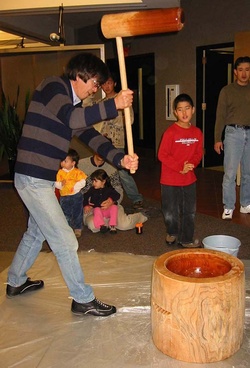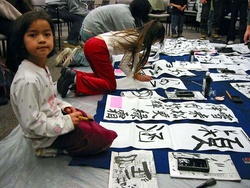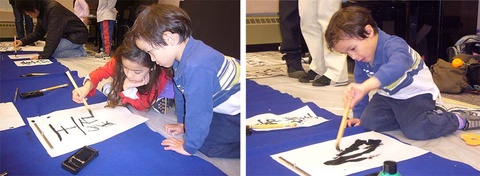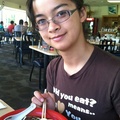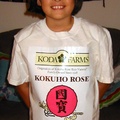As I walk with my four kids into the U-M Center for Japanese Studies, we are heartened by the thump thump thump of the kine hitting the rice in the usu. It reminds us of the burly farmhands with whom we used to celebrate Mochitsuki many years ago.
The girls start giggling, though, when they see who’s grasping the wooden mallets: skinny little professors who seem unable to capture the rhythm of pounding in a large wooden mortar.
Mochi is a pounded rice cake, and Mochitsuki is the traditional rice cake making that happens at the end of every year to preserve just-harvested rice for the winter. New Year’s Day (Oshogatsu, celebrated January 1) is a really big deal in Japan and in Japanese American communities, full of food and family and friends.
When we used to spend our Christmas holidays in California, our New Year’s Days were spent visiting one Japanese American friend’s home after the other, eating our way across town. Now, deep in the January snow, in the quiet of this college town’s New Year’s season, we are revitalized by the warmth and hubbub of this annual celebration.
My two middle schoolers find their friends from Japanese class and hang out on the fringes, eating Pocky sticks and talking about manga. Occasionally they will deign to help their younger siblings with a particularly difficult origami, but they are too cool to reveal any excitement.
Nevertheless, they were as amazed as I was one year when a professor from the U-M department of Asian languages and cultures took a brush as big as a mop, dipped it in a giant pot of black ink, and with a loud “Hai!” slammed the brush onto a sheet of paper larger than she, and in one fluid stroke, both hands on the brush, wrote one large word that you understood instantly. It was calligraphy as performance art.
At the normal-size calligraphy station, where you can try writing good wishes for the New Year with a regulation brush, eight-year-old Niu Niu calmly writes her name in kanji and helps the other people who are trying it for the first time. Little Brother patiently paints large black blobs that completely fill his paper—“Transformers.”
The wooden clack-clack of the kamishibai storyteller’s call brings four-year-old Little Brother running to hear the story of the Mighty Momotaro in both Japanese and English, each scene’s colorful pictures displayed in a wooden stagelike frame. I love the lyrical lilt of the story in Japanese, trying to pick out the few Japanese words that I know.
Little Brother is puzzled, asking, “How come I don’t understand what she is saying?”
“Just listen,” I reassure him. “You will.”
* This article originally published at Ann Arbor Observer in January, 2009. All photos are courtesy of the author.
© 2009 Frances Kai-Hwa Wang


